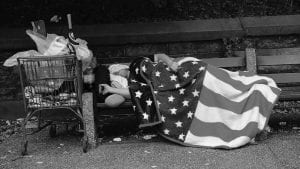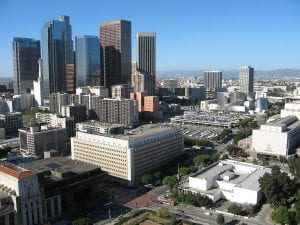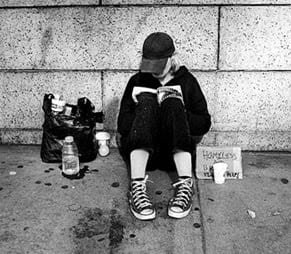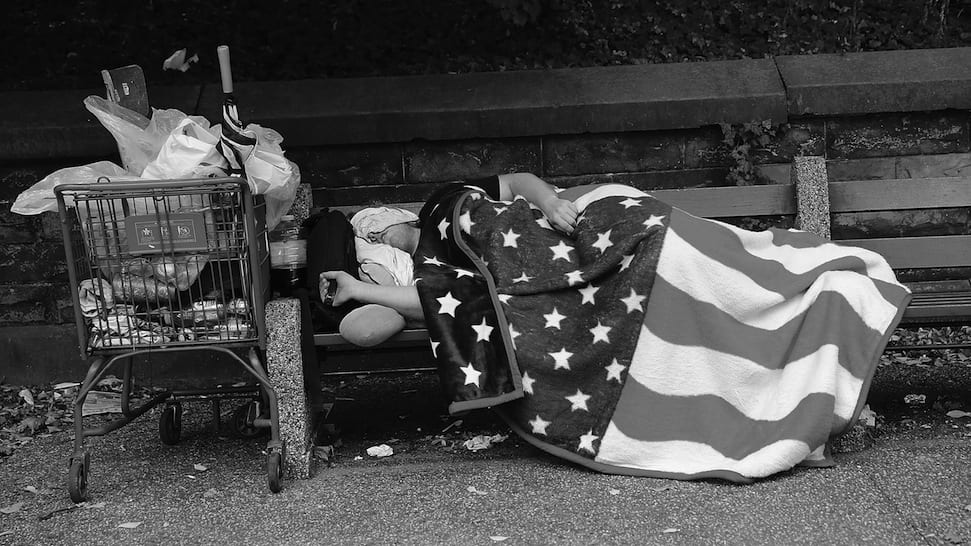Homelessness is defined as “the state of having no home.” In the 1950s, the idea of homelessness was just that, an idea. About “70% of the world’s population of about 2.5 billion people,” lived in rural areas. Today, however, it is estimated that at least 150 million people across the world are homeless with a total of 1.6 billion people lacking adequate or appropriate housing. OECD (Organization for Economic Cooperation and Development) data also ranks the United States (U.S.) as 11th behind Australia, Canada, Germany, Sweden, and others, in terms of homelessness as a percent of the total population in 2015. What is particularly interesting about these statistics is that the first two, Australia and Canada, have plans to address homelessness, with the latter two, Germany and Sweden, not having any type of national plan.
According to U.S. Department of Housing and Urban Development’s (HUD) 2018 Annual Homeless Assessment Report to Congress, an estimated 553,000 people experienced homelessness on a single 2018 night. In terms of homelessness by state, California ranked highest with a raw amount of 129,000 people and North Dakota ranked the lowest in raw count with 542 homeless people through a point-in-time count. Compared to 2008, about 664,000 people in the United States had experienced homelessness on a single night. When looking at California in 2008, about 158,000 people, more than a sixth of the total, had experienced some type of homelessness.
Sheltered Homelessness: referring to those who stay in emergency shelters, transitional housing programs, or safe havens.
Unsheltered Homelessness: referring to those whose primary nighttime location is a public or private place not designated for, or ordinarily used as, a regular sleeping accommodation for people (streets, vehicles, or parks).
Chronically Homeless Individual: referring to an individual with a disability who has been continuously homeless for one year or more or has experienced at least four episodes of homelessness in the last three years where the combined length of time homeless in those occasions is at least 12 months.

During December of 2017, “Philip Alston, the United Nations special rapporteur on extreme poverty,” visited California, Alabama, Georgia, Puerto Rico, West Virginia, and Washington, D.C., and compiled his findings into an associated report. Here, he introduces the U.S. as one of the world’s richest societies, a trendsetter, and a sophisticated place to live. After such praise, he contrasts the country with his own observations and data gathered from OECD. He also indirectly attacks the U.S., going so far as to mention that “the strict word limit for this report makes it impossible to delve deeply into even the key issues,: showing the immensity of the issues at hand that affect those living in the U.S., known as a “land of stark contrasts.”
In the same report, Alston also noted the at-the-time recent policies that the U.S. had enacted, such as tax breaks and financial windfalls (a sudden, unexpected profit or gain) for the wealthy, reducing welfare benefits for the poor, eliminating protections (financial, environmental, health, and safety) that benefit the middle class and the poor, removing access to health insurance for over 20 million people, increasing spending on defense, and many more. One of the solutions proposed to such an important issue was to decriminalize being poor.
However, leaders of cities and states may think otherwise.

For example, Los Angeles and other central cities are constantly seen with “giant cranes and construction” building towers and other magnificent architecture solely to “house corporate law firms, investment banks, real-estate brokerages, tech firms” and other ‘big-money’ companies. However, in those same cities, when looked closely, can make out “encampments of tattered tents, soiled mattresses, dirty clothing, and people barely surviving on the streets.” Alston even goes so far as to call out Los Angeles Mayor Eric Garcetti for allowing ticketing $300 to have an encampment rather than developing affordable housing for the many people unable to pay for their homes and places of residence. This exacerbates the living conditions of those charged because they are struggling to make necessary payments on time, such as healthcare, food, water, and some sort of shelter, be it a tent or living out on the street. This demonstrates that criminalizing homelessness presents an ethical issue that drags people into an endless cycle of poverty.
“Criminalizing homelessness does not solve the problem. It makes suffering more brutal and drives people living on the streets further into the shadows.” – Human Rights Watch
Looking closer to home, the 2019 Annual Homelessness Assessment Report to Congress suggests Alabama has seen progress in lowering the homelessness rate. The report ranked Alabama having the “third-lowest rate of homelessness in the country,” but also having “one of the highest rates of unsheltered homeless youth.”
According to the United States Interagency Council on Homelessness (USICH) in 2018, Alabama had 3,434 people experiencing homelessness through a community count. Below is a breakdown of each category for homelessness statistics in Alabama:
- Total Homeless Population: 3,434
- Total Family Households Experiencing Homelessness: 280
- Veterans Experiencing Homelessness: 339
- Persons Experiencing Chronic Homelessness: 540
- Unaccompanied Young Adults (Aged 18-24) Experiencing Homelessness: 158
- Total Number of Homeless Students: 14,112
- Total Number of Unaccompanied Homeless Students: 583
- Nighttime Residence: Unsheltered: 675
- Nighttime Residence: Shelters: 735
- Nighttime Residence: Hotels/motels: 681
- Nighttime Residence: Doubled up: 12,021

Looking at Birmingham, October 2018 was quite a divisive time due to disagreements and allegations for discrimination against Firehouse Ministries who were aiming to receive support from the city in order to build a new Firehouse Shelter. These allegations had caused the city council to vote down said plan, causing Birmingham Mayor Randall Woodfin to criticize such an action, stating:
“We can’t interject race into every situation. Homelessness is not an issue we should be talking about race.” — Randall Woodfin, in an interview with WBRC Fox 6 News.
However, racial disparities still exist when looking into the homeless population. According to a 2018 report from National Alliance to End Homelessness, African Americans “make up more than 40% of the homeless population, but represent 13 percent of the general population.”
Those disparities could potentially be due to “centuries of discrimination in housing, criminal justice, child welfare and education.” They are also influenced by criminal records, which African Americans are more likely to have, leading to difficulties finding housing or a job to pay for housing.
The USICH has proposed a variety of solutions that could potentially reduce the rate of homelessness if not put an end to the issue once and for all. These solution span a wide range of projects and solutions, some listed below:
- Housing First: Providing people with support services and community resources to keep their housing and not to become homeless again.
- Rapid Re-Housing/Affordable Housing: Helping individuals quickly “exit homelessness and return to permanent housing” while also being affordable to even those living in deep poverty. Access must also be available according to need.
- Healthcare: Having healthcare would allow these households to treat and manage those conditions that limit them from getting a job in the first place.
- Career Pathways: Providing accessible job trainings and employment for those living without a home.
- Schools: Providing children with schooling can be a sign of safety and connections to a broader community.
Are there any bills that have been introduced into Congress to mitigate homelessness?
Yes, H.R. 1856, titled “Ending Homelessness Act of 2019.” Introduced in March of 2019, this bill, sponsored by Representative maxine Waters of California aims to create a 5-Year Path To End Homelessness, among other things. Currently, this bill has yet to be passed in the House of Representatives before going to the Senate and President.
Homelessness is a Human Rights Issue. The lack to address it is a Violation of stated International Human Rights.
According to the United Nations Office of the High Commissioner, homelessness has “emerged as a global human rights crisis,” particularly in nation-states where resources are available to address it.
In response to questions asked by the Special Rapporteur on adequate housing in 2016, Leilani Farha, the U.S. has NOT characterized homelessness as “a human rights violation by U.S. courts.” However, certain ordinances enacted by cities have been scrutinized, such as criminalizing people experiencing homeless that sleep in public areas, partially due to the lack of shelter space. Supreme Court case Bell v. City of Boise et al addressed this very issue by determining that convicting someone of a crime due to status is in violation of the United States Constitution, particularly the Eighth Amendment, stating that convicting “a person of a crime based on his or her status amounts to cruel and unusual punishment. Simply by criminalizing homelessness through fines or through time in prison, police and other authority bodies are unconstitutionally affecting those who do not the resources to live a life of stability.
In order to end homelessness, cooperation between public and private bodies are necessary so that equitable access to housing and workforce opportunities for those who’ve been disenfranchised. Following recommendations by the USICH can help relieve many of the problems that many communities, both urban and rural, have to face while also refraining from criminalizing homelessness.

